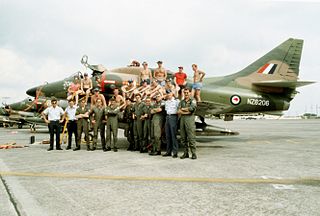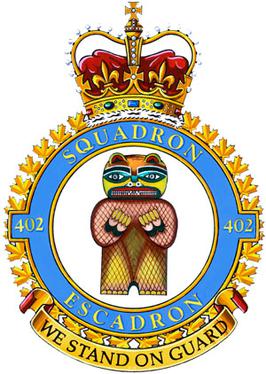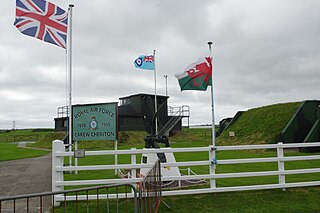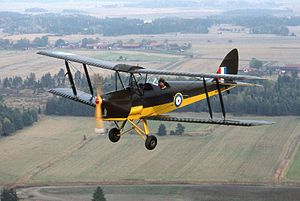
The Battle of Britain was a military campaign of the Second World War, in which the Royal Air Force (RAF) and the Fleet Air Arm (FAA) of the Royal Navy defended the United Kingdom (UK) against large-scale attacks by Nazi Germany's air force, the Luftwaffe. It was the first major military campaign fought entirely by air forces. The British officially recognise the battle's duration as being from 10 July until 31 October 1940, which overlaps the period of large-scale night attacks known as the Blitz, that lasted from 7 September 1940 to 11 May 1941. German historians do not follow this subdivision and regard the battle as a single campaign lasting from July 1940 to May 1941, including the Blitz.

The Fairey Battle is a British single-engine light bomber that was designed and manufactured by the Fairey Aviation Company. It was developed during the mid-1930s for the Royal Air Force (RAF) as a monoplane successor to the Hawker Hart and Hind biplanes. The Battle was powered by the same high-performance Rolls-Royce Merlin piston engine that powered various contemporary British fighters such as the Hawker Hurricane and Supermarine Spitfire. As the Battle, with its three-man crew and bomb load, was much heavier than the fighters, it was therefore much slower. Though a great improvement over the aircraft that preceded it, its relatively slow speed, limited range and inadequate defensive armament of only two .303 (7.7 mm) machine guns left it highly vulnerable to enemy fighters and anti-aircraft fire.

The de Havilland DH.82 Tiger Moth is a 1930s British biplane designed by Geoffrey de Havilland and built by the de Havilland Aircraft Company. It was operated by the Royal Air Force (RAF) and other operators as a primary trainer aircraft. In addition to the type's principal use for ab initio training, the Second World War had RAF Tiger Moths operating in other capacities, including maritime surveillance and defensive anti-invasion preparations; some aircraft were even outfitted to function as armed light bombers.

The Miles M.14 Magister is a two-seat monoplane basic trainer aircraft designed and built by the British aircraft manufacturer Miles Aircraft. It was affectionately known as the Maggie. It was authorised to perform aerobatics.

The Westland Lysander is a British army co-operation and liaison aircraft produced by Westland Aircraft that was used immediately before and during the Second World War.

The Armstrong Whitworth A.W.38 Whitley was a British medium bomber aircraft of the 1930s. It was one of three twin-engined, front line medium bomber types that were in service with the Royal Air Force (RAF) at the outbreak of the Second World War. Alongside the Vickers Wellington and the Handley Page Hampden, the Whitley was developed during the mid-1930s according to Air Ministry Specification B.3/34, which it was subsequently selected to meet. In 1937, the Whitley formally entered into RAF squadron service; it was the first of the three medium bombers to be introduced.

The RAF Advanced Air Striking Force (AASF) comprised the light bombers of 1 Group RAF Bomber Command, which took part in the Battle of France during the Second World War. Before hostilities began, it had been agreed between the United Kingdom and France that in case of war, the short-range aircraft of Bomber Command would move to French airfields to operate against targets in Nazi Germany. The AASF was formed on 24 August 1939 from the ten squadrons of Fairey Battle light bombers of 1 Group under the command of Air Vice-Marshal Patrick Playfair and was dispatched to airfields in the Rheims area on 2 September 1939.

No. 75 Squadron RNZAF was an air combat squadron of the Royal New Zealand Air Force. It was formed from the RAF's World War II bomber squadron, No. 75 Squadron, which had been initially equipped by the New Zealand government and was largely manned by New Zealanders. The squadron was created when, in a unique gesture, the squadron number, colours and battle honours were transferred to the RNZAF in 1946. It had flown more sorties and suffered more casualties than any other in the European theatre.

RAF Andover is a former Royal Flying Corps and Royal Air Force station in England, 2 miles (3.2 km) west of Andover, Hampshire. As well as RFC and RAF units, units of the Aviation Section, U.S. Signal Corps, Royal Canadian Air Force, United States Army Air Forces, and the Air Transport Auxiliary were also stationed at the airfield.

No. 487 (NZ) Squadron was a light bomber squadron established for service during the Second World War. It was a New Zealand squadron formed under Article XV of the Empire Air Training Plan. Although many of its flying personnel were largely drawn from the Royal New Zealand Air Force, the squadron served in Europe under the operational and administrative command of the Royal Air Force as part of Bomber Command. Formed in mid-1942, it operated the Lockheed Ventura and then the de Havilland Mosquito and took part in over 3,000 operational sorties before being disbanded at the end of the war in late 1945.

402 "City of Winnipeg" Squadron is a Royal Canadian Air Force squadron based in Winnipeg, Manitoba, Canada

Royal Air Force Bottisham or more simply RAF Bottisham is a former Royal Air Force station located 5 miles (8 km) east of Cambridge, Cambridgeshire, England.

Hucknall Aerodrome was a former general aviation and RAF aerodrome located 5 nmi north north-west of Nottingham, Nottinghamshire, England and west of Hucknall town. The aerodrome had been operated by the Merlin Flying Club since 1971 and then by Rolls-Royce Group plc. Before its closure, it was owned and operated by ITP Aero.

Old Sarum Airfield is a grass strip airfield 2 nautical miles north-north-east of Salisbury, Wiltshire, England.
Royal Air Force Filton or more simply RAF Filton is a former Royal Flying Corps (RFC) and Royal Air Force (RAF) station located 5.0 miles (8.0 km) north of the city centre of Bristol, England.

The 20th Bomb Squadron is a unit of the 2d Operations Group of the United States Air Force located at Barksdale Air Force Base, Louisiana. The 20th is equipped with the Boeing B-52H Stratofortress.

Royal Air Force Carew Cheriton, or more simply RAF Carew Cheriton, is a former Royal Air Force station located near Carew, Pembrokeshire. It was situated 4.7 miles (7.6 km) north west of Tenby.
No. 268 Squadron RAF was a Second World War Royal Air Force squadron that operated the North American Mustang on missions over occupied Europe and in support of the D-Day landings.

440 Transport Squadron is a unit of the Canadian Armed Forces under the Royal Canadian Air Force. It is part of 8 Wing and works closely with Joint Task Force (North) located in Yellowknife, Northwest Territories.

The Australian contribution to the Battle of Normandy involved more than 3,000 military personnel serving under British command. The majority of these personnel were members of the Royal Australian Air Force (RAAF), though smaller numbers of Australians serving with the Royal Navy and British Army also participated in the fighting prior to and after the Allied landings on 6 June 1944. While all the RAAF units based in the United Kingdom (UK) took part in the battle, Australians made up only a small portion of the Allied force.

















